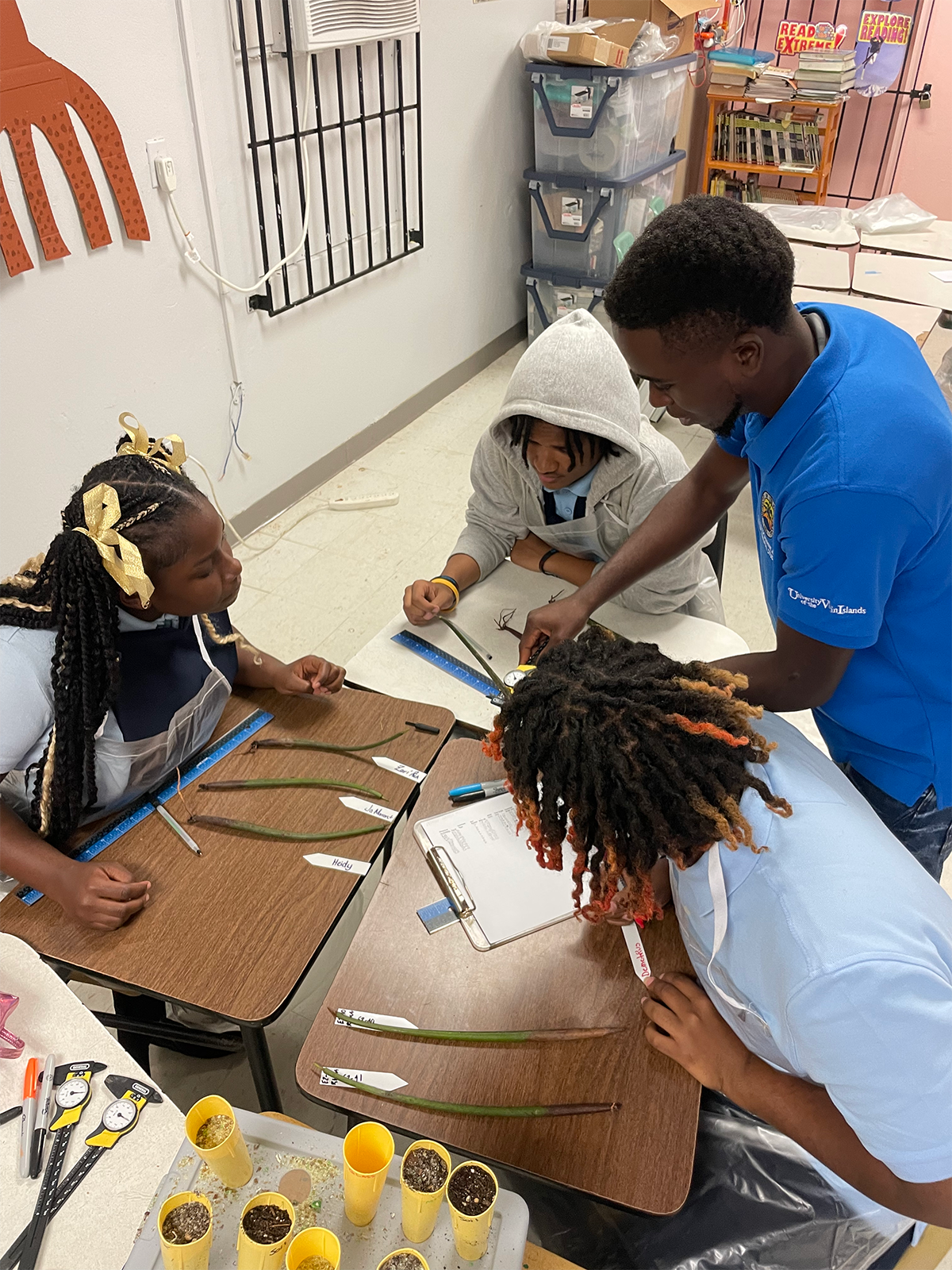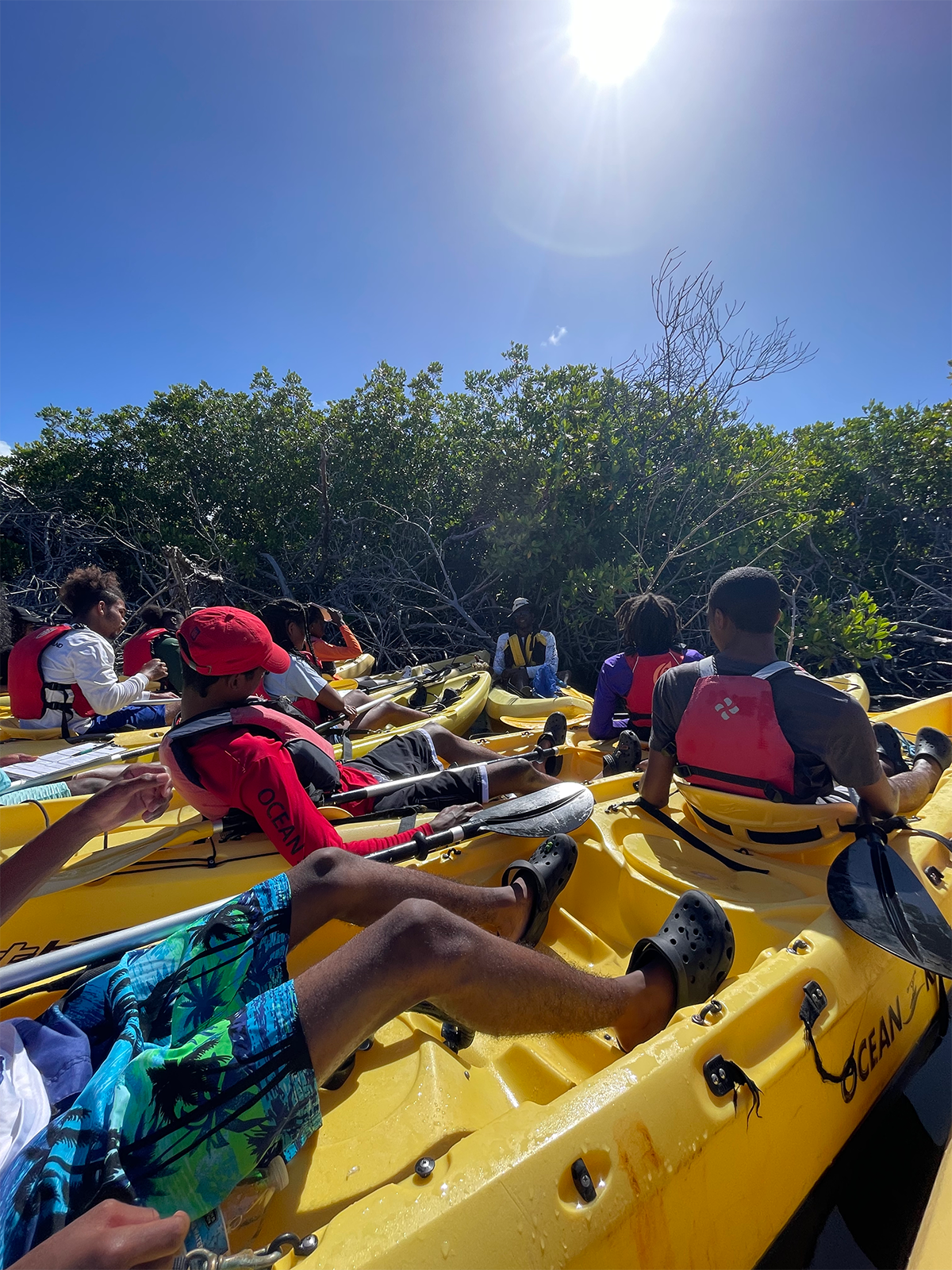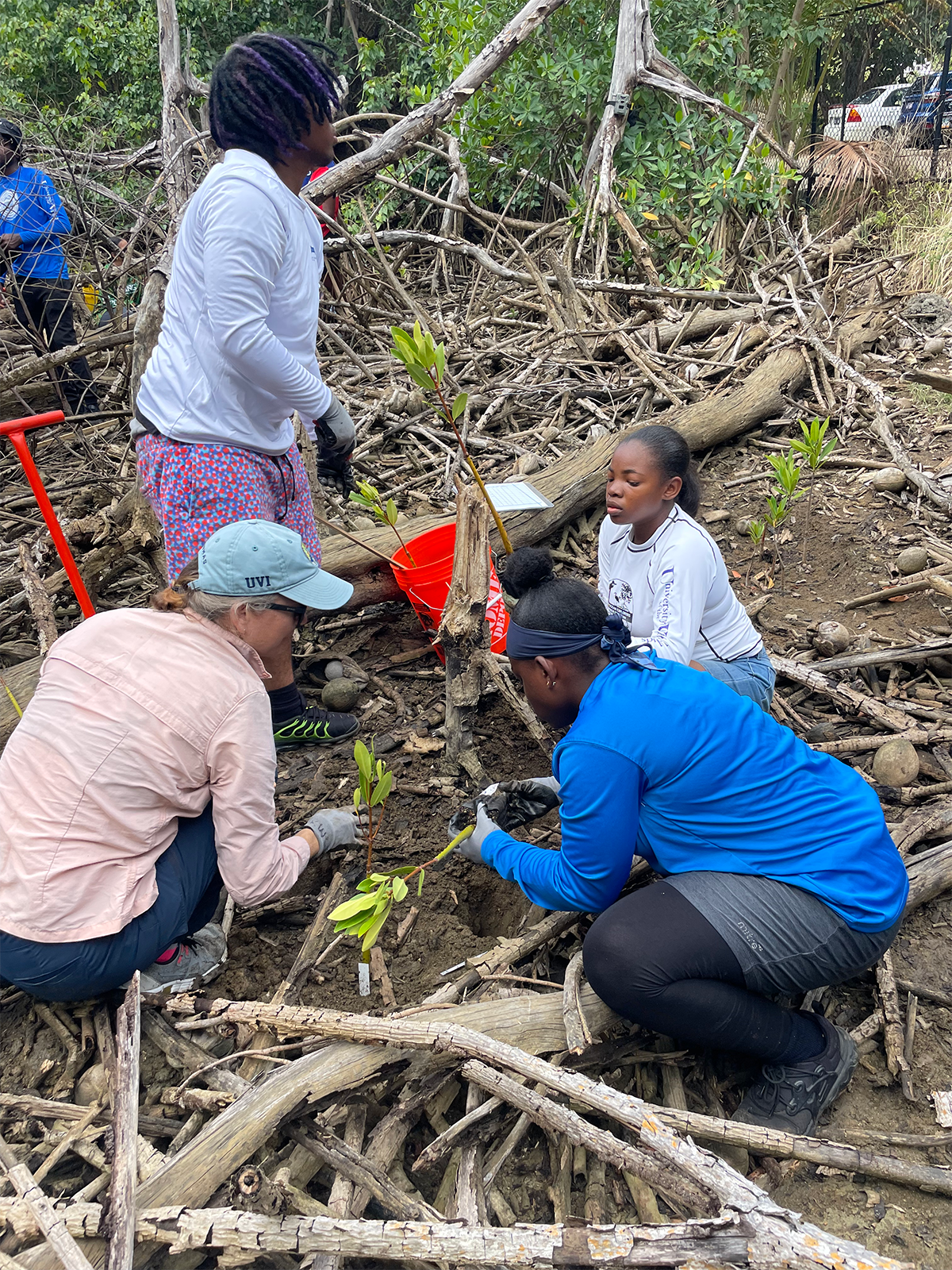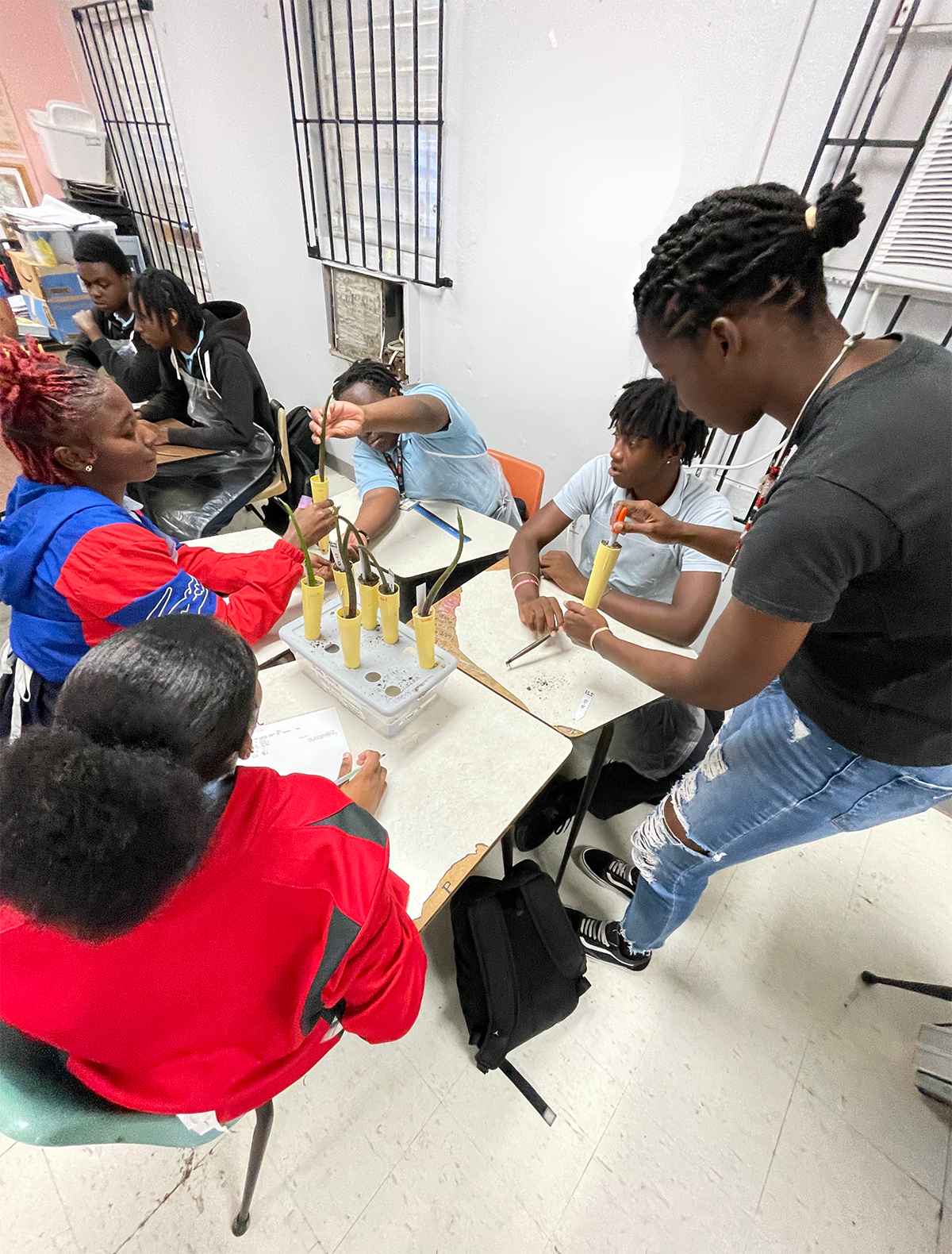Growing Green Minds: High School Mangrove Education in St. Thomas, U.S. Virgin Islands
Charlotte Amalie High School (CAHS) Biology and Marine Science students, Mr. Callwood ((CAHS educator), University of the Virgin Islands graduate students and Kerrin Tonner (U.S. VIrgin Islands Department of Planning & Natural Resources) at Cas Cay.
By: GRROE USVI Mangroves Team
Environmental education is more than academic; it's a vital pathway to conserving our natural world, showing individuals how to be stewards of the environment. This principle comes to life in St. Thomas, U.S. Virgin Islands, through a high school mangrove education project called, Mangroves in the Classroom. Over the past year, 73 students at a local public high school have engaged hands-on with mangroves, nurturing an understanding that translates into tangible action and positive environmental change.
This mangrove education initiative in St. Thomas is a novel effort that takes science beyond the traditional classroom. Students have had the hands-on opportunity to grow mangroves right within the confines of their school, and take field trips to explore these habitats first hand.
The Importance of Mangrove Ecosystems
Mangroves are extraordinary ecosystems found in tropical and subtropical regions, with a notable presence in the Caribbean. Within the U.S. Virgin Islands, these vital coastal forests are found across the territory in St. Thomas, St. John, and St. Croix.
Mangroves act as coastal guardians by protecting these islands from hurricanes and coastal erosion. Their intricate root systems store carbon, filter pollutants, and create a haven for a variety of wildlife, including commercially-important fish. However, coastal development, pollution, and climate change are threatening mangroves, posing severe risks to the ecological balance they maintain. Mangrove forests in the territory were heavily damaged by two back-to-back category 5 hurricanes in the Fall of 2017, and some areas are struggling to recover naturally. Efforts to preserve and restore mangroves in places like the U.S. Virgin Islands are important because these habitats are integral to the territory's economy and ecology.
The High School Mangrove Education Projects in St. Thomas, USVI
The Mangroves in the Classroom project at Charlotte Amalie High School (CAHS) extends learning beyond textbooks, through a place-based curriculum developed by University of the Virgin Islands (UVI) graduate student Laura Bloem, CAHS Science teacher Vernon Callwood, and GRROE USVI Mangroves, a UVI Center for Marine & Environmental Studies program. GRROE stands for Growing Research, Restoration, Outreach and Education. Students in the Mangroves in the Classroom project learn about mangroves through lessons once a week related to mangrove ecology, ecosystem services and biodiversity. Students further develop their STEM skills by conducting an in-class experiment growing mangroves in three different sediments- soil, crushed glass and a 50/50 mix of the two - over the semester. Every day students observe the mangroves growing in their classroom and bi-weekly they collect data to track plant growth rates and survivorship. At the end of the semester, students analyze their data to draw conclusions about the experiment; mangroves are then transferred to the UVI nursery where they continue to grow until they are ready to be outplanted for restoration at degraded sites.
Kwami Alexander*, UVI Securing STEM Islands Pathways Workforce Fellow, showing students Noah Powell, Zene’ Brown, and K'Lijah Hodge how to collect intake data before setting up the mangrove experiment.
Through this program, students learn outside of the classroom through field trips to local mangrove habitats, paid for by the program. One of these field trips includes a kayaking, hiking, and snorkeling trip through the St. Thomas East End Reserve (STEER) with members of the GRROE team, project partner, VI Ecotours, and partners from the U.S. Virgin Islands Department of Planning and Natural Resources. While kayaking and snorkeling through the mangrove habitats, students apply their knowledge of mangrove wildlife identification to collect biodiversity data. By interacting with the field trip and chaperone staff, students are also exposed to different career pathways open to those in the territory who work with mangroves.
A second field trip takes students to the forefront of mangrove restoration at Hull Bay, where mangroves are still recovering from the 2017 hurricanes. Working alongside the GRROE team and project partner, The Hideaway at Hull Bay, students plant mangrove seedlings in an area that used to have large red mangrove trees. This hands-on lesson helps scientists advance restoration efforts in the territory and cements the students' stewardship ethic. To date, students have helped plant 100 mangroves in this area.
Image left: CAHS Biology students learning about mangroves in the St. Thomas East End Reserves from VI-Ecotours guide Troy Willock. Image middle: CAHS Marine Science students Elyse Ayala, Zene’ Brown, K'Lijah Hodg, and Dr. Kristin Wilson Grimes planting red mangroves in Hull Bay. Image right: Amanda Boissiere helping CAHS students plant red mangroves propagules for their in-classroom experiment.
Amanda Boissiere, an undergraduate student at the University of Virgin Islands who helped develop and implement the program, noted "The Mangroves in the Classroom project was such a helpful tool for student engagement. I was able to witness many students learn about mangroves and develop a better connection with the environment.”
Significance of Mangroves in the Classroom
The significance of this project extends well beyond educational objectives. It creates a profound understanding and appreciation for mangroves. By engaging students with tangible experiences, the project enhances scientific literacy and cultivates a generation that understands the critical role mangroves play in our community. This has led to the development of a specialized, co-created mangrove curriculum that CAHS has begun to implement annually in its Marine Biology and General Biology courses, that will hopefully spread to include other local schools in the territory as this project grows.
This program also impacts early career scientists such as Amanda Boissiere a recent graduate from UVI and Laura Bloem who is currently a graduate student at UVI. Amanda reflected that, “This initiative also helped me. By teaching the students, I was able to solidify the concepts about mangrove ecology I was still learning and understanding. I was happy to play a part in this project, and I know the students enjoyed it!”
Similarly, Laura states that “...creating the mangrove lessons alongside a local highschool teacher has been a great learning opportunity for me, and I’ve been able to grow as a marine science educator. I’m excited to use what I’ve learned this past year to help this program impact more students in the Virgin Islands.”
Impact on the Community
The Mangroves in the Classroom project has served as a catalyst, sparking a greater awareness and understanding of environmental issues among students. The hands-on approach to learning about mangroves, not just as a subject in school but as a vital part of our local ecosystem, has fostered a new attitude towards conservation.
"Students get to go outside and have a true impact on improving their environment through real-world activities and experiences," Mr. Callwood observed, emphasizing the hands-on nature of the projects.
He also noted a transformation in the student's attitudes and aspirations: "Students have a greater appreciation, awareness, and eagerness to have careers that focus on saving the environment."
Looking Ahead
Through expanded funding, this project will grow this year to include another public high school on St. Thomas which serves the St. John district, and to St. Croix in the following year provided additional funds are secured. Our goal is to bring this program to 5 classrooms this fall.
*Sadly, Kwami Alexander passed away earlier this year; through this program he shared his passion for the marine environment and touched the lives of many students.






